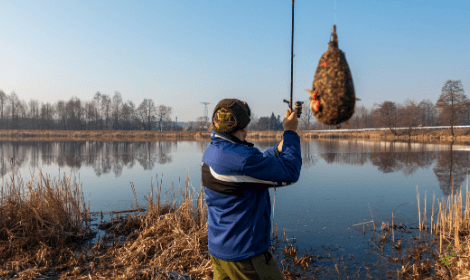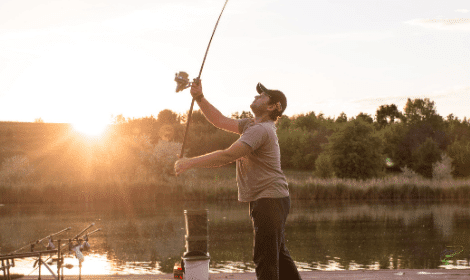
As I’m sure all you carp fishing enthusiasts are aware, method feeders are one of the best techniques for fishing for bottom feeding carp.
This technique provides an unbeatable way of casting a large ball of loose feed into the depths of the water with a perfectly presented hook bait to draw in the hungry carp.
In theory this method sounds easy, but is it?
Well yes and no.
The general steps and principles behind setting up and fishing the method feeder are actually rather simple after a bit of practice, but there’s one thing that can prove difficult for new and experienced carp anglers a like.
When fishing the method feeder you are nearly always going to want to be fishing the same swim, keeping each cast as close to each other as possible.
This is where the issues lie.
If you struggle to cast your method feeder into the same swim every cast then your fishing can become extremely inefficient and you could be loosing out on catching some nice fish.
Yep, you’ve guessed it. This post is going to focus on casting a method feeder and provide you with plenty of tips that should have you casting a method feeder like a pro in no time!
If you are looking for some more general tips take a read at these top 14 feeder fishing tips.
In this post you will find the following tips for casting a method feeder with ease;
- Correct amount of line between rod tip and feeder
- Use both hands
- Stand straight
- Point the rod tip where you want to cast
- Release at right moment
- Acknowledge the wind
- Choose the right weight of feeder
- Select a good swim
- Use the line clip
- Use the right type of rod
1. Line Between Rod Tip and Feeder
This is an extremely easy step that a lot of people can easily overlook but can have a massive influence on your cast.
By ensuring the length of line between your rod tip and method feeder is around the same every cast you ensure your casting will improve far more quickly that using any random variation for every cast.
This is because you will start to get used to the way the feeder reacts and move when at this specific length after every cast.
It is recommended to keep this distance from rod tip to feeder around 4 ft.
If the line is too short between these points then the chances are you’re not going to get enough force to cast the feeder large distances.
This 4ft of line will also help to compress the rod through the cast and will help to catapult your feeder further into the water.
If the distance is much long than this you risk touching the ground the cast, tangling line on things around you and generally the cast will be a lot harder to control with so much loose line behind you.
2. Use Both Hands

This is another extremely simple step that I fail to see so many doing on the banks.
Too many people tend to cast with one hand over the reel and cast with more of a flick of the wrist.
Don’t get me wrong this is perfectly fine if you are fishing close margins or features that don’t require a lot of distance but when trying to cast distances this should definitely be avoided.
By using two hands to grasp the rod, one hand above the reel and one at the end the rod butt you apply a lot more force to the cast.
By pulling with your bottom hand much more speed is created through the rod that results in your feeder moving at a much faster rate that should result in further casts.
3. Stand Straight
This is one that comes into play when you are struggling to cast some serious distances.
More often than not at your average fishing venue across the UK cast distances will not need to be anything too severe.
In the odd case you are fishing a large open body of water that required casts over 40-50 ft then this simple step can really make a difference.
By standing up straight you can really put a lot more effort into your cast.
For these long casts you’ll want your hands right above and over your head so standing up will give you enough clearance from your feeder to the ground.
By standing up you can also put the weight of your body into the cast which can have a massive affect on distance.
4. Point the Rod Tip
By paying attention to where you rod tip ends up through the cast you should start to see a large difference in accuracy.
When you cast your feeder should land near enough in line with your rod tip so make sure you keep your rod through a straight line through the cast.
By looking at the spot you want to cast too through the cast and concentrating on keeping your rod on a straight path you can ensure your casts will be a lot more accurate.
5. Release at the Right Time
This step is a little trickier than the few before.
To make the optimum cast you must release the line at the correct point through the cast every time.
A lot of people have no real idea where the best place to release the line is but after some practice it’s not too difficult at all.
You should aim to be releasing the line just before the rod comes directly above your head. If you imagine the point above your head being 12 o’clock you should be releasing the line when the rod tip is at around 11 o’clock.
If you release the feeder too early it will travel higher into the air and travel less distance.
If you release too late the feeder will travel downwards into the water not far from the bank.
6. Acknowledge the Wind
Casting into the wind is never an easy task and can massively affect the accuracy and distance of your casts.
If the winds are really strong I will tend to choose a swim slightly closer to the bank to give me the best chance of casting accurately.
Even better still if I know the winds are going to be high I will try to fish with the winds behind me. By doing so, in theory, you should be able to cast even further than usual.
7. Weight of Feeder
Unsurprisingly the weight of your feeder will have quite large impact on the distance you will be casting.
When fishing large open waters I will usually opt for around a 40g feeder to give me the weight required to carry the line as far as possible.
These heavy feeders also helps with anchoring your feeder on the bottom and stop them drifting with any undercurrents you can find on large bodies of water.
Heavy feeders are also good when casting to features such as an island. This will ensure your feeder stays fixed on any slopes running off from the island into the water.
8. Line Clip
By getting to know how to use the line clip on your reel you can guarantee accurate cast distances every cast.
Unfortunately the other steps will be needed to ensure you hit the same swim every time but at least the line clip will guarantee you are at the right distance every time.
You should set your line clip before you fill your feeder with any mix and without a hook bait to avoid spreading feed across the full lake which could occupy the carp away from your swim.
If you are casting to open water you can cast to your chosen swim and then simply put the line under your clip. Every time you now cast the line will never travel past the clip so you will always be casting the correct distance.
Be careful though, you should not be bashing line off the clip every cast as this can weaken the line or even break it off completely.
Also, when casting into open water and clipping up you risk large fish taking your bait and running past the line clip which can also snap your line easily.
Due to this I usually tend to only use the line clip when fishing close to islands or features. This means even if I hook into a large fish it is unlikely it will be able to run further than the line clip.
To clip up close to a feature once again cast without any feed or hook bait. I will usually cast a few feet short and then unwind a few turns of line with my hands and then clip up.
I will then cast to the clip and to see how close I am to the feature.
I will then repeat this step until I’ve reached the desired spot and then you’re ready to fish.
The video below should help explain this a little further if you are still struggling to understand;

9. Type of Rod
What type of rod you are using will also have an impact on your cast distances.
Longer rods will allow for more force through the cast and will add in propelling your feeder further.
If you plan on fishing large open bodies of water then aim for a longer rod of around 13ft.
On the other hand if you want to cast short distances accurately then a shorter rod is adequate.
Also what “action” your rod is rated at will have an impact on casting accuracy and distance.
Fast action rods will bend the least and are excellent at casting large distances.
Middle to tip rods are most suited to casting mid range distances and provide the opportunity to cast fairly far with plenty of bend in the rod when fighting fish at close distances.
Through action rods bend all the way to the rod handle and are usually only used for casting short distances with light feeders.
If you are looking for some suitable rods for carp fishing then take a look at these reviews;
That’s all you should need!
These 9 tips for casting a method feeder can make a massive difference in distance and accuracy when done correctly.
A lot might seem extremely simple but many people still seem to miss out the basics when casting.
By stripping everything back to these 9 steps casting can become a breeze.
If you manage to cast successfully to your swim every time your chances of catching can be greatly increased.
If you want to learn how to properly fish the method feeder then take a read at my full method feeder guide.
If you have any questions or would like to add any information please leave a comment below and I will get back to you ASAP!

